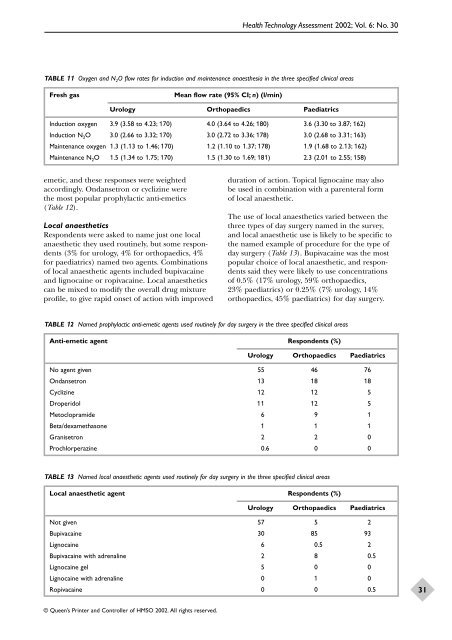Aanesthetic Agents for Day Surgery - NIHR Health Technology ...
Aanesthetic Agents for Day Surgery - NIHR Health Technology ...
Aanesthetic Agents for Day Surgery - NIHR Health Technology ...
Create successful ePaper yourself
Turn your PDF publications into a flip-book with our unique Google optimized e-Paper software.
emetic, and these responses were weighted<br />
accordingly. Ondansetron or cyclizine were<br />
the most popular prophylactic anti-emetics<br />
(Table 12).<br />
Local anaesthetics<br />
Respondents were asked to name just one local<br />
anaesthetic they used routinely, but some respondents<br />
(3% <strong>for</strong> urology, 4% <strong>for</strong> orthopaedics, 4%<br />
<strong>for</strong> paediatrics) named two agents. Combinations<br />
of local anaesthetic agents included bupivacaine<br />
and lignocaine or ropivacaine. Local anaesthetics<br />
can be mixed to modify the overall drug mixture<br />
profile, to give rapid onset of action with improved<br />
© Queen’s Printer and Controller of HMSO 2002. All rights reserved.<br />
<strong>Health</strong> <strong>Technology</strong> Assessment 2002; Vol. 6: No. 30<br />
TABLE 11 Oxygen and N 2O flow rates <strong>for</strong> induction and maintenance anaesthesia in the three specified clinical areas<br />
Fresh gas Mean flow rate (95% CI; n) (l/min)<br />
Urology Orthopaedics Paediatrics<br />
Induction oxygen 3.9 (3.58 to 4.23; 170) 4.0 (3.64 to 4.26; 180) 3.6 (3.30 to 3.87; 162)<br />
Induction N2O 3.0 (2.66 to 3.32; 170) 3.0 (2.72 to 3.36; 178) 3.0 (2.68 to 3.31; 163)<br />
Maintenance oxygen 1.3 (1.13 to 1.46; 170) 1.2 (1.10 to 1.37; 178) 1.9 (1.68 to 2.13; 162)<br />
Maintenance N2O 1.5 (1.34 to 1.75; 170) 1.5 (1.30 to 1.69; 181) 2.3 (2.01 to 2.55; 158)<br />
duration of action. Topical lignocaine may also<br />
be used in combination with a parenteral <strong>for</strong>m<br />
of local anaesthetic.<br />
The use of local anaesthetics varied between the<br />
three types of day surgery named in the survey,<br />
and local anaesthetic use is likely to be specific to<br />
the named example of procedure <strong>for</strong> the type of<br />
day surgery (Table 13). Bupivacaine was the most<br />
popular choice of local anaesthetic, and respondents<br />
said they were likely to use concentrations<br />
of 0.5% (17% urology, 59% orthopaedics,<br />
23% paediatrics) or 0.25% (7% urology, 14%<br />
orthopaedics, 45% paediatrics) <strong>for</strong> day surgery.<br />
TABLE 12 Named prophylactic anti-emetic agents used routinely <strong>for</strong> day surgery in the three specified clinical areas<br />
Anti-emetic agent Respondents (%)<br />
Urology Orthopaedics Paediatrics<br />
No agent given 55 46 76<br />
Ondansetron 13 18 18<br />
Cyclizine 12 12 5<br />
Droperidol 11 12 5<br />
Metoclopramide 6 9 1<br />
Beta/dexamethasone 1 1 1<br />
Granisetron 2 2 0<br />
Prochlorperazine 0.6 0 0<br />
TABLE 13 Named local anaesthetic agents used routinely <strong>for</strong> day surgery in the three specified clinical areas<br />
Local anaesthetic agent Respondents (%)<br />
Urology Orthopaedics Paediatrics<br />
Not given 57 5 2<br />
Bupivacaine 30 85 93<br />
Lignocaine 6 0.5 2<br />
Bupivacaine with adrenaline 2 8 0.5<br />
Lignocaine gel 5 0 0<br />
Lignocaine with adrenaline 0 1 0<br />
Ropivacaine 0 0 0.5<br />
31
















